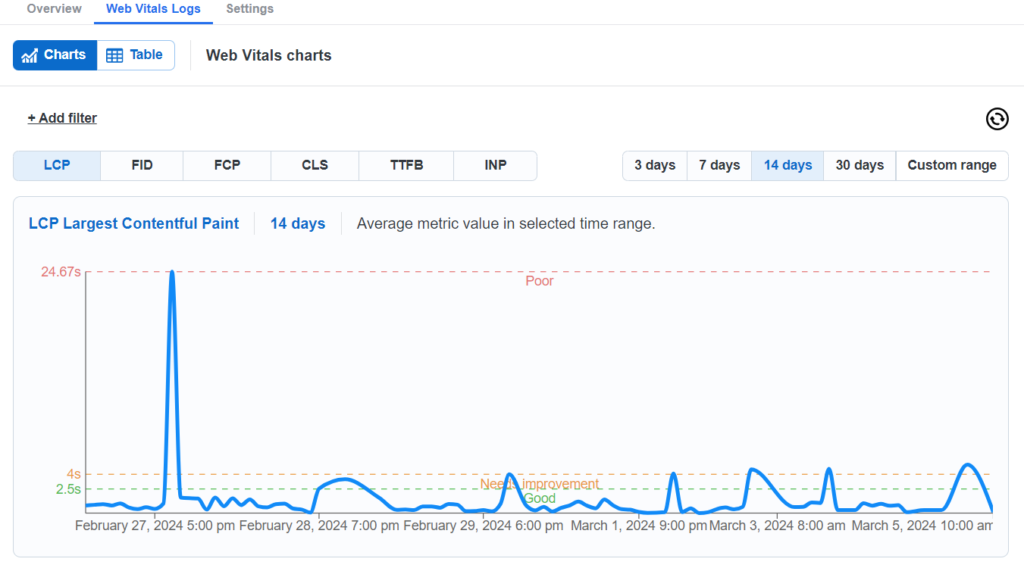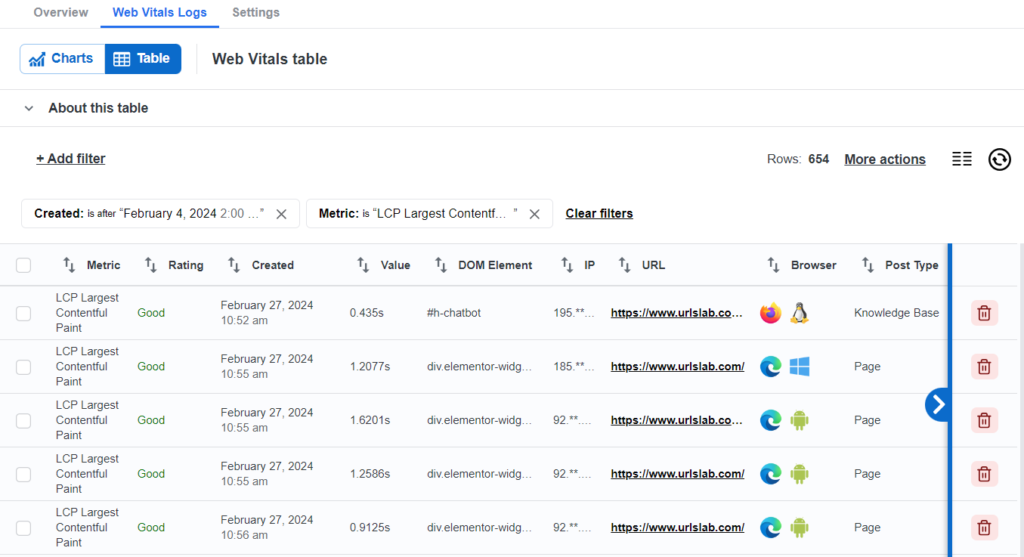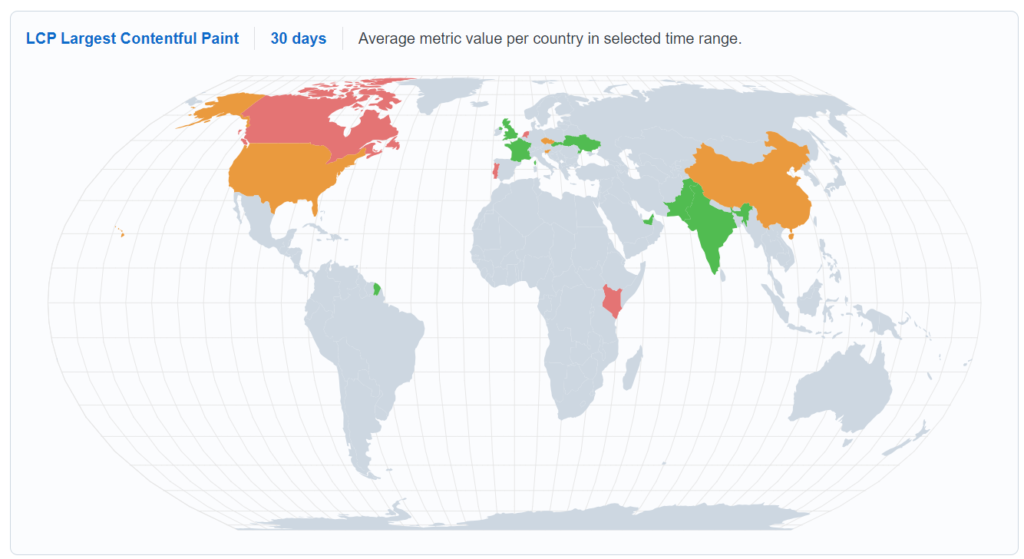WordPress Web Vitals Monitoring
URLsLab’s Web Vitals feature enables comprehensive monitoring and optimization of essential site performance metrics, improving user experience and SEO.

What is the web vitals feature?
Web Vitals is an analytical tool designed to assess website performance, focusing on critical metrics, such as Load Time (LCP), First Input Delay (FID), Cumulative Layout Shift (CLS) and more. These metrics are integral to comply with Google’s performance standards, thereby influencing search engine ranking.
How it works
The Web Vitals feature systematically gathers real user performance data, aligning with Google’s evaluation criteria. This process facilitates the identification and resolution of issues impacting Core Web Vitals scores.
For optimal database performance, it is recommended to limit the duration of detailed log storage on production environments, utilizing this feature primarily for short-term diagnostic purposes. Instead, it should be used only for short-term monitoring to identify any issues.
Web vitals log section
This section is divided into two primary modules. The first module offers a detailed view of Web Vitals through either an elaborate chart or a tabular format. The second module visualizes the average metric value per country on a geographical map.

The primary aspect to observe here is the Y-axis, which displays the quantity of URLs categorized as good, needing improvement, or in a poor state. These metrics are derived from the recommended times of GSC (Google Search Console), enabling users to assess the performance of their pages accurately.
This leads us to the table, an alternative format of presentation. Users can apply advanced filters to identify specific URLs with issues. This feature is particularly beneficial as URLsLab provides a more detailed analysis compared to GSC.

Users also have the option to export this table to a .csv file for further analysis or to share it with a website developer for prompt resolutions. As illustrated in the screenshot of the URLsLab Web Vitals feature, users can apply multiple filters and also adjust the date range of these issues for precise identification.
Web vitals map
The second module provides insights into which countries are experiencing issues with web vitals metrics. Understanding the competitive landscape and the minimum standards within your country or your audience’s country is beneficial. Users have the ability to select the metric and the date range for the results.

Web vitals settings section
In this section, you can configure various aspects of the URLsLab Web Vitals feature.
Activate Web Vitals Measurement: This function integrates a compact JavaScript library into your website’s code, enabling real-time Web Vitals measurements directly from your visitors’ browsers.
CLS Measurements: Enable logging for Cumulative Layout Shift (CLS).
Read more about the CLS – https://web.dev/articles/cls
LCP Measurements: Enable logging for Largest Contentful Paint (LCP).
Read more about the LCP – https://web.dev/articles/lcp
FCP Measurements: Enable logging for First Contentful Paint (FCP).
Read more about the FCP – https://web.dev/articles/fcp
FID Measurements: Enable logging for First Input Delay (FID).
Read more about the FID – https://web.dev/articles/fid
INP Measurements: Enable logging for Interaction to Next Paint (INP).
Read more about the INP – https://web.dev/articles/inp
TTFB Measurements: Enable logging for Time to First Byte (TTFB).
Read more about the TTFB – https://web.dev/articles/ttfb
Minimum Log Level: Retain log entries that meet or exceed the chosen severity threshold.
URL Filter: Set up measurements to monitor performance exclusively for URLs matching a specified regular expression pattern.
Attribution Measurements: Attribution tracking, while comprehensive, demands significant storage capacity beyond standard logging. Extensive use in a production environment is not recommended. Nonetheless, it stands as the sole approach for uncovering root causes behind poor performance on individual pages.
Upon identifying the principal problem, it is advisable to deactivate this feature, focusing instead on observing performance metrics without detailed data collection.
Maintenance settings: To manage database size effectively amidst potentially thousands of daily Web Vitals log entries, configure how long logs are kept in the database. User can set the duration for storing Web Vitals logs in the database, measured in hours. The default setting is 168 hours, equivalent to one week.

What are the benefits of URLsLab’s web vitals feature?
URLsLab’s Web Vitals feature offers a comprehensive tool set designed to enhance the performance and user experience of your website. By embedding this feature, you gain access to critical insights into your site’s health through vital metrics like LCP, FID, CLS, and more. The benefits include:
- Improved site performance: Pinpointing and addressing issues related to load times, responsiveness, and visual stability can significantly boost your site’s overall performance.
- Enhanced user experience: By monitoring and optimizing for key web vitals, you contribute to a smoother, more engaging experience for your visitors.
- Search engine optimization: As these metrics are factored into search engine rankings, optimizing for web vitals can help improve your site’s visibility in search results.
- Detailed analytics: Access to real-time and historical data enables targeted improvements and the ability to track progress over time.
- Customizable monitoring: With options to filter by URL, set log severity, and control data storage, you can tailor the feature to meet your specific needs.
How to test the web vitals feature?
Testing the Web Vitals feature within URLsLab is a straightforward process designed to provide you with actionable insights quickly:
- Enable the feature: Activate the Web Vitals tracking option within your URLsLab settings. This will start collecting data from actual users visiting your site.
- Configure your parameters: Set the specific metrics you wish to monitor, such as CLS, LCP, FID, etc. You can also define the log duration and severity levels.
- Export and analyze: Use the export function to download the data for offline analysis, or utilize URLsLab’s intuitive dashboard to view metrics and identify areas for improvement.
- Implement changes: Based on the insights gathered, make the necessary adjustments to your site, focusing on areas highlighted by the data.
- Rinse and repeat: Continual monitoring and repeated testing cycles are key to maintaining optimal web performance and user experience.
Tips for using the web vitals feature
Maximizing the benefits of the Web Vitals feature involves a strategic approach and best practices:
- Set clear goals: Determine what success looks like for your website in terms of performance and user experience.
- Focus on high-impact metrics: Prioritize the improvement of metrics that will have the most significant impact on your site’s performance.
- Monitor regularly: Regular analysis allows for early detection of issues and the opportunity to address them proactively.
- Utilize advanced filtering: Make use of the URL filter feature to hone in on specific areas of your site that may be underperforming.
- Balance data collection and storage: Be mindful of the balance between collecting detailed data for analysis and the storage implications of extensive logging.
- Engage developers early: When improvements are needed, involve your web development team early in the process to discuss and implement fixes efficiently.
Frequently asked questions
- What is URLsLab’s Web Vitals feature?
URLsLab’s Web Vitals feature is an analytical tool for monitoring and optimizing critical site performance metrics like LCP, FID, and CLS, directly impacting user experience and SEO.
- How does the Web Vitals feature work?
It gathers real user performance data, aligns with Google’s evaluation criteria, and provides detailed analytics through charts, tables, and maps to identify and resolve site performance issues.
- What are the main benefits of using this feature?
Key benefits include improved site performance, enhanced user experience, better SEO rankings, access to detailed analytics, and customizable monitoring tailored to your needs.
- Can I customize the metrics monitored?
Yes. You can configure which metrics to track (LCP, FID, CLS, FCP, INP, TTFB), set log duration, severity levels, URL filters, and manage database storage.
- How do I test URLsLab’s Web Vitals feature?
Enable the feature, configure desired parameters, analyze data via dashboard or export, implement changes, and repeat the monitoring process for continuous optimization.
Optimize Your Website Performance
Leverage URLsLab’s Web Vitals feature to enhance your site's speed, stability, and ranking. Monitor, analyze, and optimize effortlessly.


